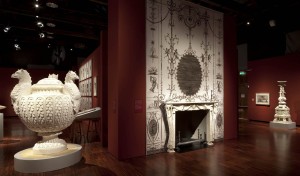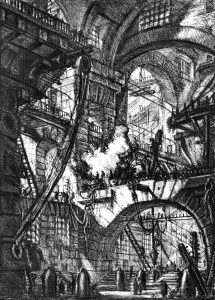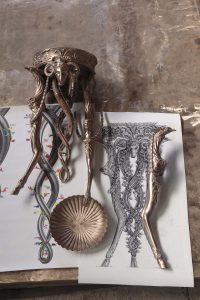A Time Warp of “Camp”: De Lucchi, Piranesi, & Factum Arte at SDMA
“It’s astounding―Time is fleeting
Madness takes its toll…”*
The above lyrics written by Richard O’Brien for the campy musical theater production of The Rocky Horror Show seem a very appropriate way to think about the exhibition Piranesi, Rome, and the Arts of Design now on view at the San Diego Museum of Art in Balboa Park. Like the pivotal gender bending mad genius character Frank ‘N’ Furter who continuously alters his persona in O’Brien’s play, Giambattista Piranesi (1720-1778) was also a mad genius who perpetually had to alter his persona from architect to printer and an influential designer of the Rococo and Neoclassical periods to finally become an architectural historian.
Piranesi, Rome, and the Arts of Design is a “Time Warp” collaboration between Italian designer Michele De Lucchi who is famous for his 1980s contributions to the outlandish provocative Italian design group Memphis, the Giorgio Cini Foundation, and Factum Arte that is a Madrid company known for its use of cutting-edge technology to make museum quality reproductions of historical artifacts and computer animations.
Giambattista Piranesi (1720–1778). “View of the Romano Campidoglio with Staircase that Goes to the Church of Araceli.” Image courtesy of Fondazione Giorgio Cini, Venice.
The exhibition was organized by the Cini Foundation to showcase the foundation’s encyclopedic collection of prints by the Venetian-born Piranesi. The foundation’s prints are from the Firmin Didot edition of the architect/designer’s etchings. The French typefounder Firmin Didot purchased Piranesi’s printing plates at auction in 1829 and reproduced the artist’s etchings from 1835 through 1839.
In his early days while still living in his hometown, Piranesi trained in theater design and rendering. He later wanted to become an architect, so he moved to Rome believing he might have better chance obtaining architectural commissions there. No such luck.
“Let’s do the Time Warp again….
It’ just a jump to the left…”*
In Rome, Piranesi was forced to alter his persona to become a printer to survive. With his skill as a draftsman this transition was not very difficult due to the relative ease of the etching process (Unlike engraving where one has to laboriously carve directly into a metal plate, etching uses a process of coating a metal plate with a resisting wax or tar-like coating and then one draws a design into the “resist.” The plate is then put into an acid bath to “etch” away the metal wherever the resist has been removed). Piranesi made architectural etchings of famous views of Rome (called “vedute”) depicting his views of the city’s landmarks in an overtly grand, romantic style that glamorized the actual ruination of the Eternal City. He also created imaginary architectural fantasies by placing ancient landmarks within scenes of more recently built landmark architecture. He sold both his vedute and imaginary architectural renderings to tourists eager to possess an idealistic memento from their requisite “Grand Tour.”
In the exhibition is one of his grandest etchings of a romantic ruin, “Capriccio Grottesco: Nero’s Tomb” (1750) from his Opere Varie suite of etchings. This classic rococo style work features the image of Nero’s tomb virtually collapsing before the viewer’s eyes due to the sublime neglect of time. Swarming with writhing snakes, the tomb is battered and broken from being slowly torn apart by the roots of plants that have invaded virtually every crack and crevice of the tomb. The etching’s dramatic highlights and shadows and swirling asymmetrical composition are a tour de force of unbridled rococo exuberance.

Design by Giambattista Piranesi (1720–1778), produced by Factum Arte. “Vase with Three Griffin Heads,” 2010. Marble composite. “Marble Fireplace Mantle with Cast Iron Andirons,” 2010. White marble and cast iron. Image courtesy of Factum Arte and SDMA.
“And then a step to the right.”*
In the early 1760s, Piranesi transformed himself again additionally becoming an architectural historian. He began executing several suites of etchings accurately documenting the monuments of ancient Rome. Two astounding etchings from a series of etchings, executed from 1774 to 1779, document the Column of Trajan, which was erected as the emperor’s tomb. The two etchings are over 10-feet tall. One depicts the front view and the other shows the back view of the famous column’s spiraling bas relief that depicts Trajan’s two victorious military campaigns over the Dacian civilization in 101–102 CE and 105–106 CE. Every one of the approximately 2500 figures from the 625-foot spiraling frieze is included in Piranesi’s two immense prints. Two sets of six huge copper plates were etched and placed end to end to print each image. They are grandly staged in the exhibition and their innumerable tiny details are mindboggling.
“…the pelvic thrust
That starts to drive you insane….”*

Giambattista Piranesi (1720–1778). “Prison (Carceri d’invenzione),” ca. 1761. Image courtesy of Fondazione Giorgio Cini, Venice.
The most famous and influential etchings by Piranesi are a suite of sixteen images of gruesome imaginary prisons entitled Carceri d’invenzione (“Imaginary Prisons”), 1761–63. These famous prisons are a revision (termed as a “second state”) of an earlier edition of the fantasy architectural prisons. The original cleaner, brighter edition didn’t sell very well. Ten-years later he revised his original plates using his early training as a set designer to further etch the original plates with more theatrical lighting. This transformed the suite into a more dramatic series having a dark sinister psychological quality. He also added more contradictory architectural elements to the images. The second state of the Prisons may have inspired the dark moody quality of Goya’s famous Los Caprichos etchings. They also influenced cinematic masterpieces such as Fritz Lang’s Metropolis and even surrealist artist Roberto Matta claims to have been inspired by Piranesi’s dark visions.
Of the sixteen images from the famous Carceri d’invenzione, one of the most crazed and amazing is “The Gothic Arch” with its dramatic vaulted arches, eight stairways and numerous mazes of walkways all leading nowhere, which surrealist artist M.C. Escher quoted in his architectural fantasies. The most sinister image from the series is “The Pier with a Lamp,” where a small pier supports the crushing weight of consecutive arching groin vaults. The small pier sports four gruesome heads each burdened with a heavy hitch ring drooping from each of their mouths. The drama of the implied weight of the depicted architecture, deep shadows, and gruesome heads combine to become a deliciously sinister fantasy.
“It’s so dreamy…”*
Enter designer Michele De Lucchi and Factum Arte: De Lucchi commissioned Factum Arte to create a twelve-minute movie that allows a viewer to wander through the dark sinister spaces of the Carceri. It is an amazing spectacle of animation. The movie pans around to move a viewer throughout each of the sixteen etchings of the Carceri d’invenzione: winding up the staircases, under the vaulted spaces, and over the catwalks featured in each print. The movie takes a viewer on a fantastic voyage through the dark architectural spaces and is a not to be missed highlight of the exhibition.

Design by Giambattista Piranesi (1720–1778). A work in process by Factum Arte. “Tripod,” 2010. Gilt bronze with silver coating and a top of alabaster. Image courtesy of Factum Arte.
“―Oh, fantasy free me…”*
Factum Arte was also tasked to reproduce many of the rococo furnishings that Piranesi designed when he transformed himself into a furnishing designer. In 1769, he published an album of etchings entitled Diverse Maniere d’adornare i cammini (Diverse Ways of Different Ways of Decorating Chimney-Pieces). For this exhibition Factum Arte reproduced many of Piranesi’s designs of fireplaces and several other of his designs as well. One is a full-size 23-carat gilt Grotto chair featuring a large scallop shell as the back. The company also reproduced a rococo sterling silver coffee pot in the shape of a conch shell riding a small turtle with the spout in the shape of a bumble bee. Several display tables in the show are covered with the experiments, materials, and casts that Factum Arte used to make the ornate objects. Other reproductions include spectacular ornate tripod tables, a griffin legged altar made of silver-patinated bronze, and plaster replicas of huge candelabrums.
All these objects are visually so over-the-top ornate that they fit several of Susan Sontag’s definitions of “Camp”:
“5. … camp art is often decorative art, emphasizing texture, sensuous surface, and style at the expense of content….
8. Camp is a vision of the world in terms of style―but a particular kind of style. It is the love of the exaggerated, the ‘off,’ of things-being-what-they-are not….
12. The question isn’t, ‘Why travesty, impersonation, theatricality?’ The question is, rather, ‘When does travesty, impersonation, theatricality acquire the special flavor of Camp?’”
――Sontag, “Notes on ‘Camp’”
The overall exhibition was designed by Michele De Lucchi with much panache. Beautiful raw wood frames each of Piranesi’s prints. Soothing paint colors cover the walls. Exquisite lighting effects highlight the objects. De Lucchi designed this Piranesi exhibition with the emphasis on style.
Like the camp play, The Rocky Horror Show, where O’Brien intentionally infused the play with the camp subject of androgyny and harvested B-grade movies for their sense of style and lack of substance. Piranesi, Rome, and the Arts of Design now on view at SDMA is also “camp” as everything in the exhibition is a theatrical impersonation. The etchings were not produced by Piranesi himself during his lifetime but printed 57-years later by a Paris type foundry. The objects were reproduced in 2010, 232-years after Piranesi’s death. The designer of the exhibition, Michele De Lucchi, was the perfect maestro for this excessive spectacle. However, this exhibition does fit within Piranesi’s own artistic practice as he, himself, designed objects using ideas and forms harvested from the depths of history without reason except to design something spectacular.
“In another dimension―With voyeuristic intention…”*
Piranesi, Rome, and the Arts of Design is similar to The Rocky Horror Show and the cult movie it spawned, the exhibition is a delightful orgy of visual delights and elegant fakery. Perhaps one should not think of Piranesi, Rome, and the Arts of Design as an exhibition but more as a single, grand camp artwork itself―a vision of spectacular excess by De Lucchi as harvested from Giambattista Piranesi. Experience De Lucchi’s extraordinary work of camp before it closes on July 7, 2013 as it is worthy of its own “Rocky Horror”-type cult following.
“Nothing can ever be the same….”*
Exhibition run: March 30, 2013 through July 7, 2013.
*(Lyrics from the song “The Time Warp” from the original stage play The Rocky Horror Show. The composer and lyricist was playwright Richard O’Brien. The play debuted in London at Royal Court ‘s experimental Theatre Upstairs in June 1973. The play is now known as Richard O’Brien’s The Rocky Horror Show. Copyright © 1983 by Richard O’Brien and Copyright © 1998 & 1999 by Richard O’Brien).
© 2013 by Kraig Cavanaugh

I wish I had read this article before I saw the show!
The review is really enlightening and explains many of the angles of the exhibition I was unaware of.
Now I feel compelled to go back to SDMA and take an other look.